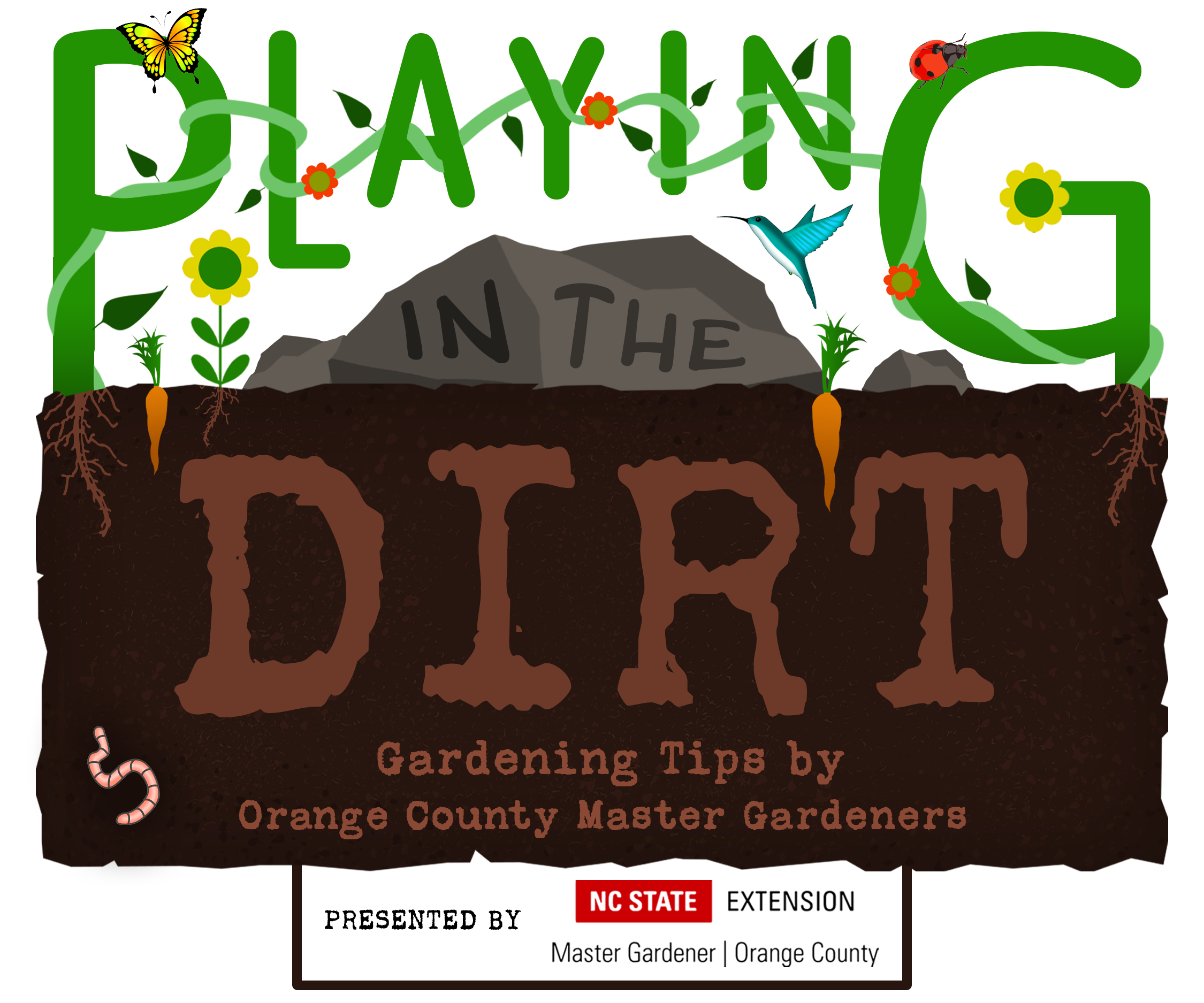
97.9 The Hill and Chapelboro.com have partnered with Orange County Master Gardeners for “Playing in the Dirt,” a monthly column exploring the fertile ground of home gardening in our community and intended to provide the information and inspiration gardeners of all skills levels need to flourish! Check back on Chapelboro each month for a new subject – from our gardens to yours!
By Meg Molloy, Orange County Master Gardener volunteer

Along the Pond Wall
You may have noticed a recent shift in what is considered the all-American yard. Many people are moving away from expansive, manicured lawns that require significant time, herbicides, water and gas-powered mowers to maintain. There is a shift toward layered plantings emphasizing beautiful trees, shrubs, flowers, native grasses, vines and groundcovers that attract monarch and other butterflies, bees, moths, birds and other wildlife. Herbs and vegetables are interplanted in the garden as people explore growing their own food. Gardens are reimagined with smaller, sustainable lawns featuring a greater biodiversity of plants.
This shift supports a healthier environment and an interest in exploring gardening as a creative outlet. Fortunately, the trend away from turf grass to more environmentally focused gardens has been supported by two Orange County towns that have amended their ordinances on landscaping. The towns of Hillsborough and Carrboro (see Article II, Section 11-9) have established ordinances on managed natural landscapes; these local laws guide residents on how to replace turf grass with natural landscapes to promote habitat for pollinators and wildlife and reduce pollutants and use of chemicals.
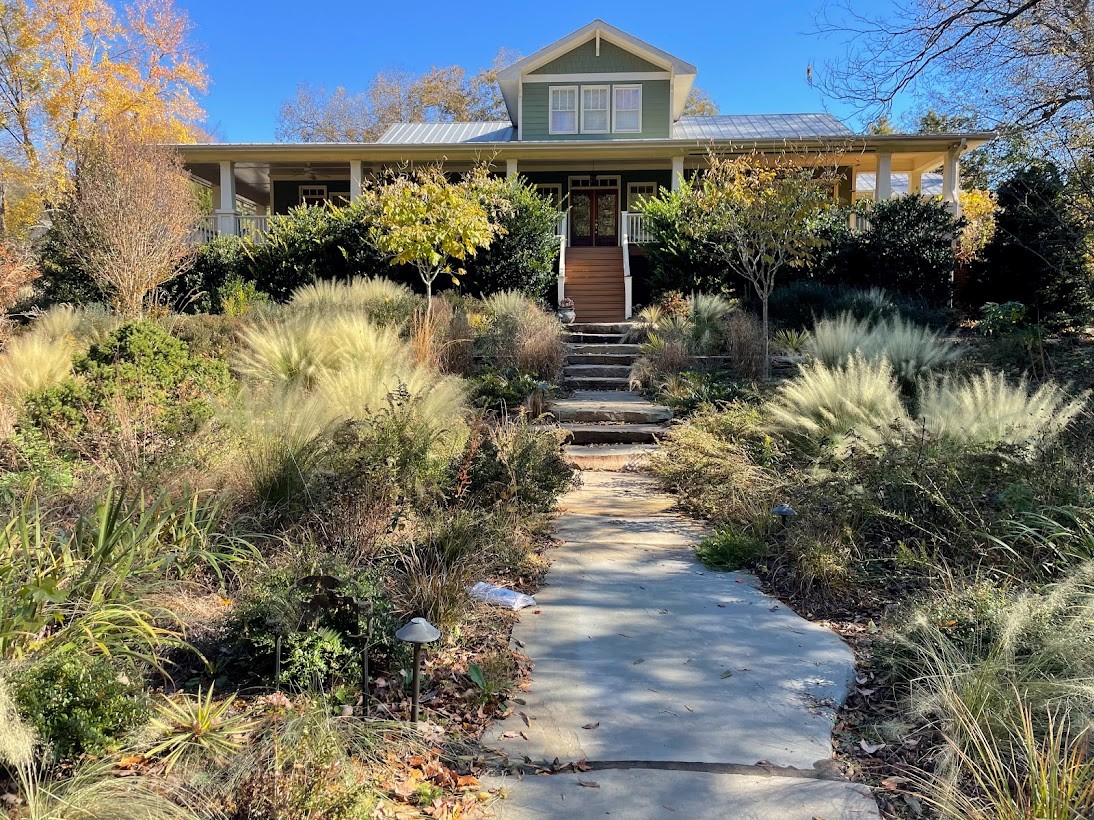
Anna Linvill’s Front Walk
A Hillsborough Managed Natural Oasis
Anna Linvill has converted her Hillsborough yard to an oasis of beautiful plantings aligned with the Town’s managed natural landscape ordinance. When she and her family moved to Hillsborough, they found that their yard tended to flood during heavy rains. Mud was a constant battle. The grass needed to be mowed weekly, which was challenging on a steep slope; and mowing did nothing to alleviate the flooding and erosion, nor to promote infiltration of pollutants. She also spent endless hours trying to control invasive plants such as stilt grass and English ivy.
Anna decided to transform her garden so that she wasn’t constantly battling water, erosion, invasives and mud. Her aim was to work with the natural conditions of the terrain to create a more ecologically healthy and natural landscape. She had several goals in mind: create an aesthetically pleasing hardscape that incorporated structure, balance, scale, texture, scents, color and four-season interest; catch, slow down and direct water runoff; encourage natural plant communities and wildlife to thrive. To prepare for the project, Anna visited the North Carolina Botanical Garden in Chapel Hill to learn about managed natural landscapes and NC native plants, and she did a lot of reading.
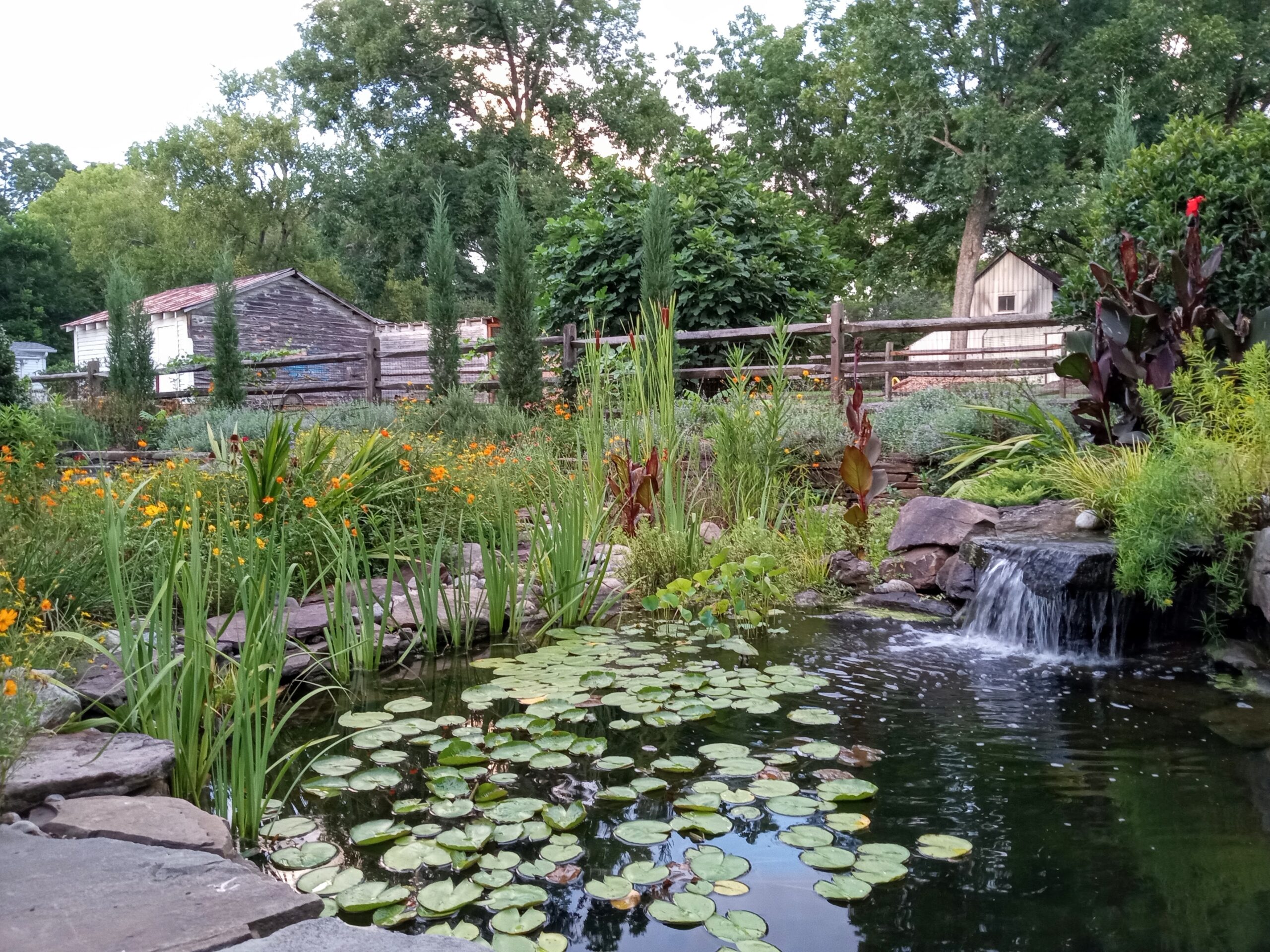
Water Feature with Wetland Plants and Grasses
To implement her plan, Anna created a wet natural area where a rain gulley had flowed, brought in large Pennsylvania field stone to redirect water and add structure, added wetland plants and grasses and created a no-mow zone. She is experimenting with sedges (Carex) and Green and Gold (Chrysogonum virginianum) for groundcovers, and native (for example, several types of goldenrod, Solidago) and non-native plants that outcompete invasives and change growing conditions to reduce their spread. Plantings Anna enjoys include paperbush (Edgeworthia chrysantha) underplanted with violets, Green and Gold and wood asters; the exfoliating bark of Virginia Sweetspire (Itea virginica); and witch hazels. (See the North Carolina Extension Gardener Plant Toolbox for all types of plants.)
In only one season, Anna had a completely different yard. She found that sedges, juncus and wild iris began growing in the no-mow zone, and that bees, toads and other wildlife discovered the welcoming habitat.
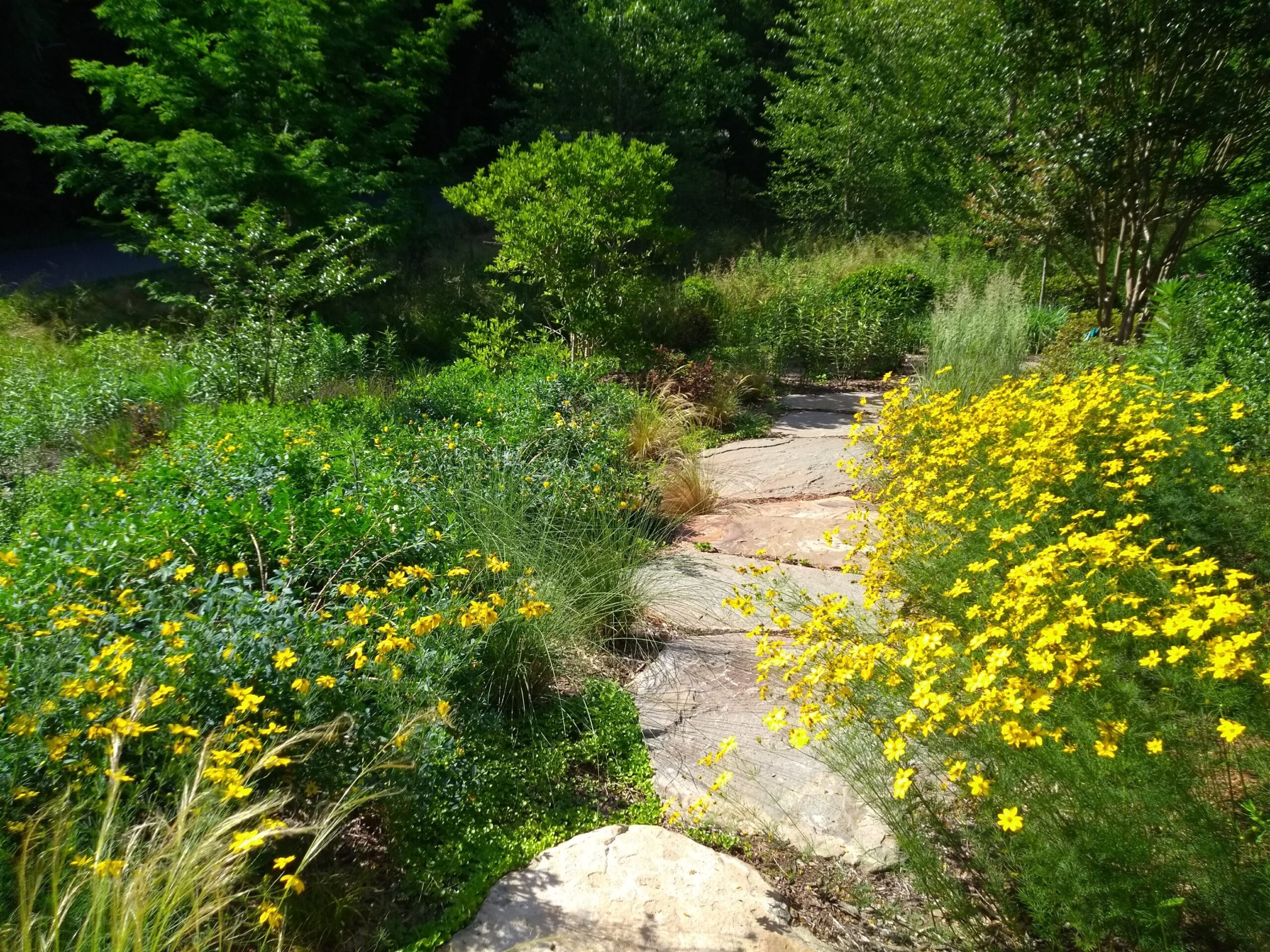
Coreopsis and Grasses Along Stone Path
Anna finds that working with nature reduces being overwhelmed with garden maintenance and brings year-round enjoyment. She notes that by humbly learning to let go, being less controlling and more of an editor, she is developing something more sustainable. Anna’s advice: “I’d love to see more people exploring their creative self in their garden. It’s so much more fun than a lawn.”
Consider these approaches to reduce turf grass and create a beautiful, more sustainable yard:
- Reduce herbicide and pesticide use in grass areas to encourage plant biodiversity, which also reduces the need for routine watering. Add spring ephemeral bulbs to lawns for early spring color; these flowers come and go before you need to mow. Recognize that clover and violets bring value to a sustainable lawn. They are excellent groundcovers; the clover is nitrogen fixing and violets support several native fritillary butterfly species and native bees.
- Convert sections of lawn to an attractive alternative. Consider starting with slopes that are challenging to seed and mow. Grow sedges (Carex) and ferns on shady slopes or native iris, Green and Gold, milkweeds, lavender and rosemary on sunny slopes. Underplant blue eyed grass, dwarf crested iris, carpet phlox, creeping verbena, and mayapples under eastern columbine, coreopsis, cardinal flower, and iron butterfly for a succession of colorful native pollinators.
- Instead of grass as the primary groundcover, create natural areas by leaving the leaves, add steppingstones interplanted with low growing herbs or install a mulched garden bed. A variety of groundcovers add texture and interest and suppress weeds. Leaving the leaves on your garden bed is far easier than raking and bagging and the leaves protect beneficial insect eggs. Leaves are an inexpensive and effective mulch and build healthy soil.
- An easy way to convert grass to a natural area or garden bed is by sheet mulching: use newspaper and cardboard to smother grass where you want to reduce lawn, and layer with compost, leaf mulch and wood chip mulch. Water it in and give it time to suppress grass, attract worms and create a healthy soil base for plantings.
- Build a garden — rain garden, native perennial garden, edible garden or wildflower meadow. Create a canvas for your plantings: use a rope, hose or string to define an area that you want to convert and prepare the bed. See the video series below for tips on garden preparation.
- Create a bird habitat by layering trees and shrubs and bird boxes and birdbaths in a natural, leaf litter area.
- With less lawn area, you can say goodbye to the fuss and mess of a gas-powered mower and switch to a battery operated or electric mower. They reduce the use of fossil fuel and are far less noisy. Good for the climate and good for your neighbors!
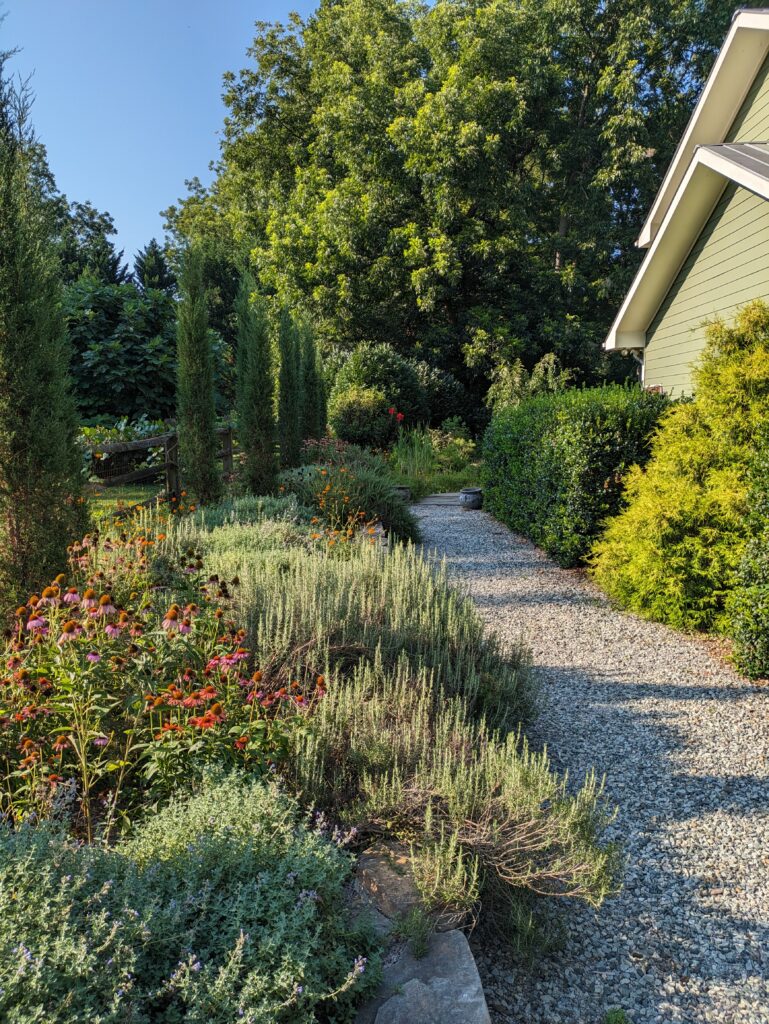
Side of House Garden with Herbs, Coneflowers and Shrubs
Check out these videos to learn more!
The Orange County Master Gardener volunteers created a video series to support the Town of Hillsborough’s managed natural landscape ordinance and help residents establish native plants, edible landscapes and rain gardens.
- Native Plants: The Hillsborough managed natural landscaping ordinance allows residents to replace high-maintenance lawns with native plants. Native plants provide food and shelter for wildlife and support pollinators which sustain over 75% of the world’s plant species. In this video, Orange County Master Gardener volunteers discuss natural landscaping, suggest native plants for sun and shade gardens and outline how to get started.
- Edible Landscaping: Edible landscaping, or “foodscaping,” is a way to add vegetable and fruit plants to existing garden beds and containers instead of planting a separate food garden. Tucking edible plants among flowers saves space, discourages weeds, adds interest to your yard and provides pollinator habitats. In this video, Orange County Master Gardener volunteers show you how to do it!
- Rain Gardens: Installing a rain garden is a cost-effective and attractive way to enhance your home’s beauty and value while decreasing stormwater runoff and pollution in local creeks and waterways. Native plants are good choices for rain gardens — they are hardy and they benefit wildlife. Orange County Master Gardener volunteers created this video for people interested in learning more about the simple steps involved in installing a rain garden of any size.
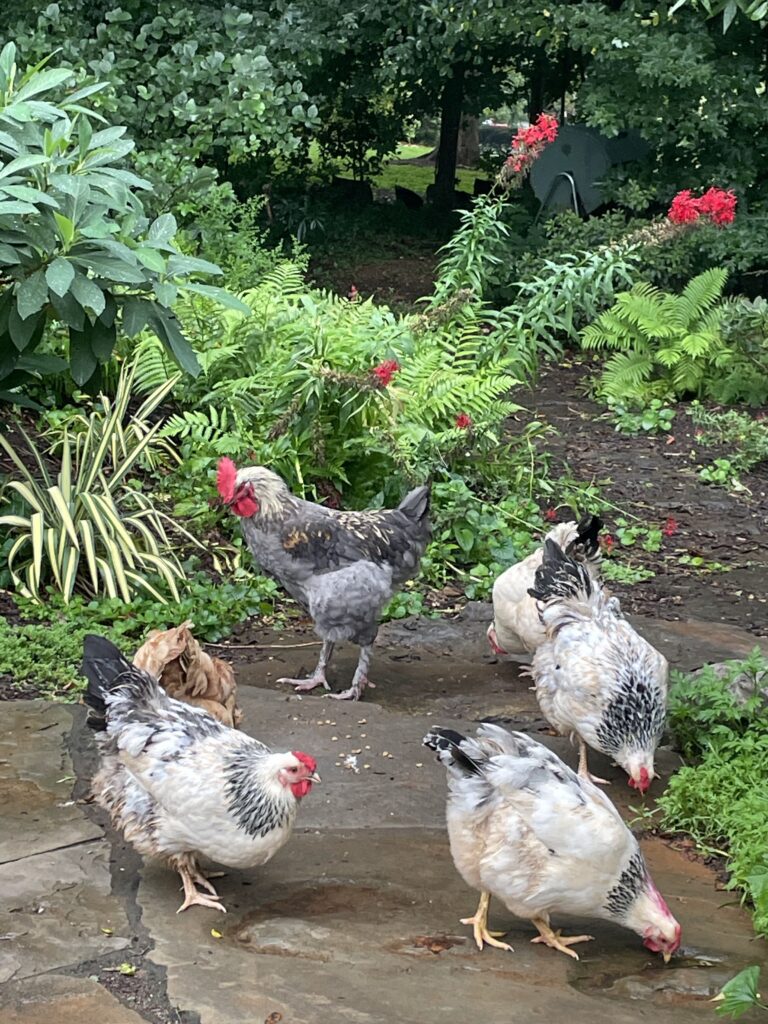
Ferns, Yucca and Chickens
(Thank you to Anna Linvill for all the photos!)
A Few Other Resources:
- Krystal D’Costa, The American Obsession With Lawns, Scientific American, May 3, 2017.
- What Can I Plant Instead of Grass? NC Cooperative Extension, Caldwell County.
Check Us Out!
- Have a plant or garden question? Email the Orange County Master Gardener volunteers at ocmgardeners@gmail.com or phone 919-245-2061.
- Follow us on Facebook! Our page is Orange County NC Extension Master Gardener Volunteer.
- Subscribe to The Garden Buzz, the Orange County Master Gardeners’ monthly newsletter, for gardening news and tips. And visit our website, The Orange Gardener.
- Save the date! The Orange County Master Gardener volunteers will hold PlantFest, a plant sale and festival, on Oct. 14, 2023, 9 a.m. to 2 p.m., at 1020 US 70 W, Hillsborough, NC 27278.
Chapelboro.com does not charge subscription fees, and you can directly support our efforts in local journalism here. Want more of what you see on Chapelboro? Let us bring free local news and community information to you by signing up for our biweekly newsletter.

